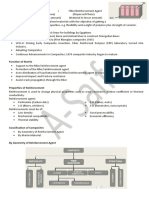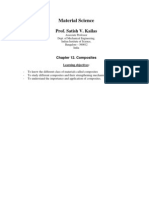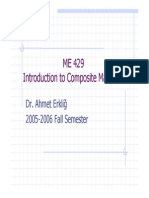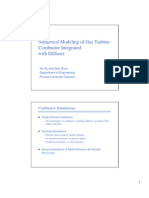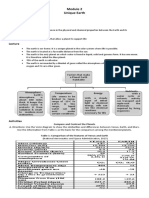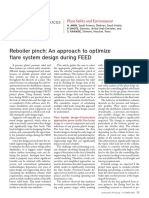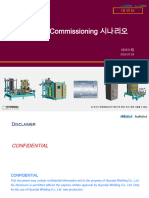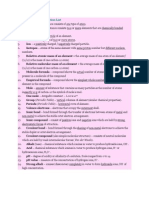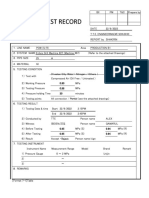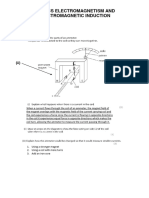KH6064MAA Materials Analysis and Advanced Manufacturing
7. Theory and Technology of Composite Materials
Dr. Ahmed Shaker
Assistant Professor of Mechanical Engineering
School of Engineering
�Contents
1. Introduction
2. Particle reinforced composites
3. Fiber reinforced composites
4. Polymer matrix composites
5. Metal matrix composites
6. Ceramic matrix composites
7. Hybrid composites
8. Processing of fiber reinforced composites
9. Structural composites
School of Engineering
�Definition
Composite materials are formed by the combination of two or more materials such that
resulting properties are superior to those of its constituents
The design of modern structures often requires material capabilities, which are difficult to
obtain with traditional materials.
School of Engineering
�Advantages of composite materials
1) Low-density and light weight
2) High-strength and stiffness
3) High-damping
4) Thermal-shock resistance
5) High fatigue behavior
6) High corrosion resistance
7) Fire resistance
8) Ability to form complex shapes
9) Very tolerant to environmental effects such as UV damage, moisture, chemical
attack and temperature extremes.
School of Engineering
�Disadvantages of composite materials
1) Properties are generally anisotropic (they differ depending on direction)
2) Complex repair process
3) Generally expensive
4) Manufacturing methods often slow
5) One of the most common types of layered composite failure is delamination
(debonding of one layer from another)
School of Engineering
�Applications of composite materials
Aerospace as planes of Boeing 777 (and in 767,
787 airplanes)
Fiberglass is a popular material for boats and
marine sector. This composite material is
lightweight and is suited for every weather
condition.
School of Engineering
�The main reason for the shift towards composite
trucks is the lighter load, the resulting fuel savings
and the composite trucks work well in all climates.
Fiberglass reinforced polymer (GFRP) plays an
important role in manufacturing trains, busses, metros,
and trams. Its lightness and rigidity make it the perfect
material for public transportation. They are
characterized by their fire safety.
School of Engineering
�Glass Fiber with suitable matrix is used in water pipes for
their high strength and corrosion resistance. (tubes of 1.5m
diameter, 1km long tube).
Wind energy is a renewable energy resource, composites
are used in manufacturing of wind mill blades for their
high stiffness, low density, and good fatigue performance.
School of Engineering
�Components in Composite Materials
Most of composite materials consist of two phases:
1. The primary phase in which the other phase is embedded: Matrix
▪Such as metal, ceramic or polymer.
▪It transfer load to reinforcement
School of Engineering
�2. The secondary phase or imbedded phase that strengthens the composite:
Reinforcement
▪ In the form of fibers, particles, flakes or various other geometries.
▪ Provide an improvement in tensile strength, stiffness and impact resistance to the
material.
Shapes of embedded phases in composite materials: (a) fiber, (b) particle, and (c) flake
School of Engineering
�There are geometrical and spatial characteristics of the dispersed phase that may influence
the properties of composites
a) Concentration
b) Size
c) Shape
d) Distribution
e) Orientation
School of Engineering
�The Interface and Interphase
Interface is between the primary and secondary phases in a composite material
Interphase a third ingredient (component) must be added to achieve bonding of
primary and secondary phases can be thought of as an adhesive
School of Engineering
�Types of composite materials
I- Classification based on the matrix type
School of Engineering
�II- Classification based on the reinforcement type
School of Engineering
�Particle reinforced composites
Dispersion-
Large particle
strengthened
The distinction between these two types of materials is based on
reinforcement or strengthening mechanism.
• Particle-matrix interactions • Particles are much smaller
cannot be treated on the (10-100 nm)
atomic or molecular level • Particle-matrix interactions
• Continuum mechanics is used are on the atomic or
• The particulate phase is molecular level
harder and stiffer than the
matrix
School of Engineering
�Fiber-reinforced composites
The mechanical characteristics of fiber-reinforced composite depend not only on the
properties of the fiber, but also on the degree to which an applied load is transmitted to the
fibers by the matrix.
∗
𝜎𝑓 𝑑
𝑙𝑐 =
2𝜏𝑐
Under an applied stress, the fiber-matrix bond ceases at the fiber ends, yielding a matrix
deformation pattern.
School of Engineering
�Influence of fiber length
School of Engineering
�Influence of fiber orientation and concentration
Parallel
alignment
Orientation
Random
alignment
Better overall composite properties are realized when the fiber
distribution is uniform.
School of Engineering
�Stress-Strain relationship for longitudinal loaded material
(in the direction of fiber alignment)
School of Engineering
� Elastic behavior
(longitudinal loading ) 𝐹𝑐 = 𝐹𝑚 + 𝐹𝑓
𝜎𝑐 𝐴𝑐 = 𝜎𝑚 𝐴𝑚 + 𝜎𝑓 𝐴𝑓
If the composite, matrix and fiber 𝐴𝑚 𝐴𝑓
phase lengths are all equal 𝜎𝑐 = 𝜎𝑚 + 𝜎𝑓
𝐴𝑐 𝐴𝑐
𝜎𝑐 = 𝜎𝑚 𝑉𝑚 + 𝜎𝑓 𝑉𝑓
𝑭𝒄 is the total load sustained by the composite
𝜀𝑐 = 𝜀𝑚 = 𝜀𝑓
𝑭𝒎 is the carried load by matrix
𝑭𝒇 is the carried load by fiber 𝜎𝑐 𝜎𝑚 𝜎𝑓
= 𝑉𝑚 + 𝑉𝑓
𝑬𝒄𝒍 is the modulus of elasticity of continuous and 𝜀𝑐 𝜀𝑚 𝜀𝑓
aligned fibrous composite 𝐸𝑐𝑙 = 𝐸𝑚 𝑉𝑚 + 𝐸𝑓 𝑉𝑓
𝐸𝑐𝑙 = 𝐸𝑚 1 − 𝑉𝑓 + 𝐸𝑓 𝑉𝑓
School of Engineering
�Assignment
𝐹𝑓 𝐸𝑓 𝑉𝑓
Prove that =
𝐹𝑚 𝐸𝑚 𝑉𝑚
School of Engineering
�Elastic Behavior – Transverse Loading
𝜎𝑐 = 𝜎𝑚 = 𝜎𝑓 = 𝜎 Isostress state
𝜀𝑐 = 𝜀𝑚 𝑉𝑚 + 𝜀𝑓 𝑉𝑓
𝜎 𝜎 𝜎
= 𝑉𝑚 + 𝑉𝑓
𝐸𝑐𝑡 𝐸𝑚 𝐸𝑓
1 𝑉𝑚 𝑉𝑓
= +
𝐸𝑐𝑡 𝐸𝑚 𝐸𝑓
𝐸𝑚 𝐸𝑓 𝐸𝑚 𝐸𝑓
𝐸𝑐𝑡 = =
𝑉𝑚 𝐸𝑓 + 𝑉𝑓 𝐸𝑚 1 − 𝑉𝑓 𝐸𝑓 + 𝑉𝑓 𝐸𝑚
�School of Engineering
�School of Engineering
�School of Engineering
�School of Engineering
�Thank you!





